#english mustard powder
Text
#jamie oliver#celebrity recipes#egg yolks#creme fraiche#english mustard powder#sea salt#chilli jam#chilli-pepper chutney#worcestershire sauce#welsh rarebit
1 note
·
View note
Text
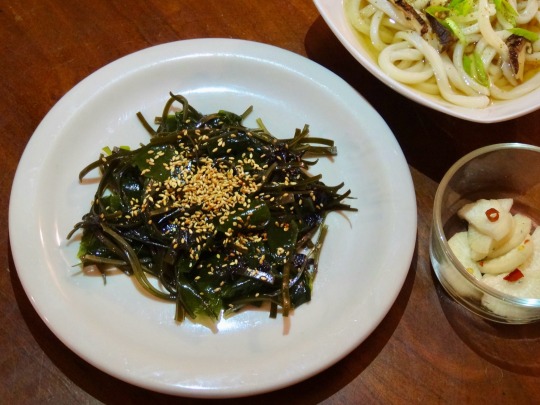

[ID: First photo shows a mixed seaweed salad topped with toasted sesame seeds; in the background are bowls of pickled daikon and kake udon. Second photo is a close-up showing light shining through the seaweed. End ID]
わかめと昆布サラダ / Wakame to konbu sarada (Seaweed and kelp salad)
A wide variety of seaweed-based salads are made by Japanese home cooks. They may contain only a mix of seaweeds and a dressing, but may also feature vegetables including cucumber, carrots, lotus root (レンコン / はす), daikon (だいこん), corn, edamame (枝豆), or onion. Dressings are as varied as cooks, and may be based around sesame oil (ごま油), rice vinegar (米酢), miso paste (みそ / 味噌), ponzu sauce (ポン酢), or mayonnaise (マヨ).
This recipe is a good way to use up reconstituted kombu and wakame that were steeped to make soup stock. It includes instructions for two dressings: one based on rice vinegar and sesame oil, and another with a sesame-mayo base.
"わかめ" or "ワカメ" ("wakame") is likely from "若" ("waka," "young") + "海布" ("me," "seaweed"); it is a particular species of edible seaweed (Undaria pinnatifida) that is farmed in Japan, Korea, and China. It is sometimes called "sea mustard" in English. Without further specification, "wakame" in a culinary context is taken to mean the leaves of the seaweed; these are the same leaves that are eaten in miso soup (みそ汁).
The etymology of "昆布" ("kombu" or "konbu") is unknown. It may be a phonetic Japanese reading of the Middle Chinese "昆布" (Mandarin: "kūnbù") (itself from "綸布" "*krūn pās," "green ribbon" + "cloth"), used to refer to various types of kelp and seaweed. In Japanese, the term refers to any of a few species of edible kelp from the Laminariaceae family.
Dried kombu is steeped to make one type of dashi ("出汁" / "だし"), a stock that is used in various soups and sauces. Once reconstituted, it may be steeped again to make 二番だし ("niban dashi," "second dashi"), sliced and simmered as one ingredient in a 煮物 ("nimono," simmered dish), or roasted and combined with other seaweeds and spices to make 振り掛け ("furikake").
"サラダ" ("sarada") is probably derived from the English "salad."
Note that the "seaweed salad" served at Japanese restaurants in the U.S. is not commonly eaten in Japan. It is shipped out to restaurants and stores pre-packaged, and is made with colored オゴノリ ("ogonori"; "agar" on ingredients lists), きくらげ ("kikurage"; "wood ear mushroom" or "fungus" on ingredients lists), and byproducts of wakame including 茎わかめ ("kukiwakame," wakame stem) and メカブ ("mekabu," wakame sprouts; both listed as "wakame" or "seaweed" on ingredients lists). You may be able to find this salad in the freezer section of your local Asian grocery store. If you want to approximate the texture of this salad at home, try buying some mixture of ogonori, kikurage, kukiwakame, mekabu, モズク ("mokuzu"), and/or ひじき ("hijiki"). Instructions for the dressing are below.
Recipe under the cut!
Patreon | Paypal | Venmo
Ingredients:
For the salad:
2 cups total reconstituted kombu, wakame, hijiki, or other kelp or seaweed
Vegetable additions to seaweed salads are possible and common. Try adding some cucumber, julienned carrots, sliced lotus root, sliked daikon radish, corn, edamame, or sliced onion that's been soaked in plum vinegar for 15 minutes.
If you're including cucumbers, slice them, salt them, allow them to drain in a colander for about 10 minutes, then gently squeeze them of excess liquid, to avoid making your salad watery.
For dressing 1:
1 Tbsp unseasoned rice vinegar (米酢)
1 Tbsp toasted sesame oil (煎りごま油)
1/2 kosher salt
1/2 tsp vegetarian granulated sugar
1/2 tsp Japanese soy sauce (しょうゆ / 醤油) (such as Kikkoman's)
2 tsp toasted sesame seeds (いりごま)
To make U.S. restuarant-style seaweed salad, omit the soy sauce; replace the sugar with high fructose corn syrup; and add a pinch of cayenne pepper, 1/4 tsp of onion powder or yeast extract, and a pinch of MSG.
For dressing 2:
2 Tbsp vegan mayonnaise
1/2 tsp unseasoned rice vinegar (米酢)
1/4 tsp dried ground shiitake mushroom, or vegetarian dashi powder
1/4 tsp vegetarian granulated sugar
Drop of djion mustard
Pinch kosher salt
1 tsp Japanese soy sauce (しょうゆ / 醤油) (such as Kikkoman's)
Drizzle of mirin (みりん)
2 tsp toasted sesame seeds, ground in a mortar and pestle or spice mill
If you eat eggs, you can replace the first five ingredients with 2 Tbsp Kewpie mayo (キューピーマヨ).
For a halal version, replace the mirin with an extra pinch of sugar.
Instructions:
For the salad:
1. Slice kombu into very thin strips. Slice wakame into thin strips, or leave as-is, as desired. Slice other flat dried seaweed into thin strips or bite-sized pieces.
For dressing 1:
1. Whisk all ingredients except sesame seeds together in a small bowl. Toss with seaweed. Top with sesame seeds and serve cold.
For dressing 2:
1. Whisk all ingredients together in a small bowl. Toss with seaweed. Serve cold.
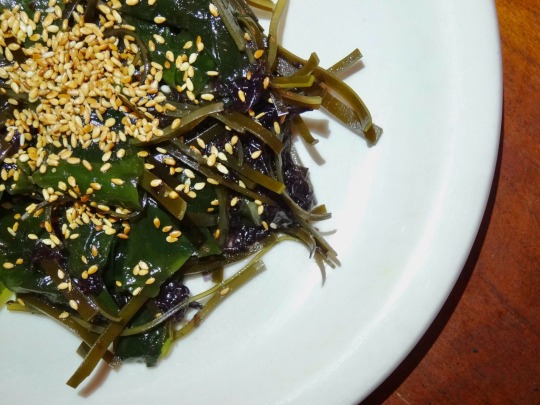
67 notes
·
View notes
Text
What I think the League of Villains would order at Starbucks bc I work there and I need entertainment sue me
~Disclaimer idk what Starbucks is like in Japan so I'm basing it off of the USAmerican Starbucks~
Shigaraki - Absolutely the sugarist thing on the menu. Pink drink with sweet cream cold foam on top; Iced white mocha with sweet cream cold foam, caramel syrup and extra caramel drizzle; iced pumpkin spice latte with sweet cream cold foam and extra pumpkin- you get the jist. The least sugary thing he's ordered was a french vanilla iced coffee and even then he asked for extra classic
Kurogiri - He doesn't like to drink much coffee, and if he does he has to brew it himself. Thus, he's one of like five people that gets the English Breakfast tea.
Dabi - Doesn't understand most of the drink names, doesn't care enough to. If someone is ordering for them, they'll get the "purple one" (Dragon drink). If they're ordering for themself it'll be a hot latte - vanilla if they're feeling fancy if not just a regular latte- or a mocha hot no whip. (They feel proud of themself for knowing to say "no whip". They should not be)
Toga - She's a pretty simple gal actually, never really gets an overly complex order. If it's in season she'll get an iced pumpkin spiced latte, if not she'll just get an iced white mocha. Is usually the one to order everyone's drinks if they're going in a group
Twice - She'll usually be unable to decide what he wants to drink and will debate about it for ten minutes before deciding on what she always orders- an iced black tea lemonade unsweetened. Before the huge splitting apart + trauma he'd always get a grande blonde roast with extra half and half.
Big Sis Magne - She's a simple gal. A simple tall black pike for her, sometimes a tall black iced coffee- no classic- if it's really hot outside. She also is the only one with a Starbucks app and always has Toga scan her account whenever the League orders. The stars she gets from their orders is enough to get free drinks for at least four weeks. Will order everyone's drinks if Toga is unavailable.
Mr. Compress - For him it's either the Passion Tango tea lemonade (sweetened, obviously) or a Mango Dragonfruit lemonade refresher. No matter the drink though he always asks for six splenda. Regardless of type of drink or size. No one knows why.
Moonfish - Will order the NASTIEST fucking drinks known to man. A trenta iced coffee, 10 pumps of classic, 10 pumps of vanilla, 10 pumps of toffeenut, 10 pumps of caramel, 6 scoops of vanilla bean powder, extra heavy cream, and caramel drizzle. Or what about a trenta pink drink made with heavy cream, sweet cream cold foam on top, seven scoops of vanilla bean powder, and 10 pumps of vanilla syrup.
Muscular - He wants a pink drink so bad. He wants that shit deep in his soul. He is too cowardly and orders a grande dark roast with two stevias.
Mustard - Give him a venti double chocolaty chip frappuccino no mocha sub white mocha and he'll happily sip on that shit for the entire day.
Bonus round:
Bakugo - Gets either a strawberry cream frappuccino no classic sub vanilla or a blonde vanilla latte if it's later at night. Caffeine makes him sleepy so he usually goes for the non caffeinated drinks.
Hawks - Fans speculate what drink he gets. They assume it's something like an iced vanilla coffee or iced toffeenut coffee. This is incorrect. Coworkers assume he gets pink drinks or iced pumpkin spiced lattes. This is also incorrect. He gets a hot cinnamon dolce latte and an everything bagel.
If people like this I'll do the entirety of Class 1-A.
Since I know no one is going to read this I used headcannon pronouns get off my dick
#sascha says shit#cw food#shigaraki tomura#big sis magne#twice#toga himiko#kurogiri#mr. compress#dabi#muscular#moonfish#mustard#bakugo katsuki#hawks#takami keigo#my hero academia#mha#boku no hero academia#bnha#league of villains
76 notes
·
View notes
Text
Folks from the US getting condescending about people not from the states has to be my least favourite genre of posts. Like, i swear every other week I see some shit written in half baked (british) english slang about baked beans or jellied eels or rotten teeth and it drives me up the wall. Just a bunch of fundamental misunderstandings about a place they've never been too with little to no curiosity about what life might actually be like there.
Im only coming at this from a UK angle so cant speak for anywhere else but a quick rundown on all this shit states side people get wrong about our food specifically because thats what winds me up the most.
Beans on toast is a cheap staple breakfast food, not the cornerstone of our cullinary tradition.
In most urban city centers you get a complex mix of diaspora informed food stuffs, primarily indian and east asian because of all that colonialism we did. Relatively large muslim populations also bring in middle eastern influences.
Even what you might think of as a classic british pub will sell you a basic curry unless you're in the arse end of nowhere. This is not niche shit. Our whole food culture is shaped by this.
What you could call 'classic' british cooking like full roast dinners with Yorkshire puddings, propery gravy, sruffung, and all the other fixings are fucking great actually. Bit of lamb with mint, bit of pork with apple sauce, cut of beef with mustard. It goes hard.
Even if you are in the arse end of nowhere stuff like pasties, proper pies, stews with dumplings, fish and chips, and other sea side holiday basics that make you think of little coves in north devon are also good, actually. Yes its not spiced to all hell and back, but they incoperate herbs and vegatables and stocks in ways that give it a unique depth of flavour distinct from cultures informed by a more spice heavy tradition.
Say what you will about our shit (complimentary) chicken shops and rubbery high street donner in years of nights out blind drunk in student bits of the city they've never once given me the gastric distress y'all describe post taco bell.
Of course our mexican food isn't particularly authentic, the countries half a planet away and we dont have a large mexican diaspora. What we do have is tuned for mass market appeal by largish chains or sold out of artisinal taco food trucks that we all find a bit wanky tbh.
Spicy food exists, and we quite like it. Yes even pasty white tony who turns the colour of jam when he eats a medium hot vindaloo. Indian food is a cornerstone of our national diet of course we know what chilli powder is.
And finally nobody eats fucking jellied eels it was a victorian era poverty food and even then only in london.
Also our chocolate is better than yours because we dont put the weird chemical in it that makes it taste like sick. Eat a kit kat and die mad about it.
#Had to get this rant out of my heart#Dungeon Meshi got me amped about food clearly#there is a reason our chefs go on your telly to yell at your guys#please dont break containment though spare me the disk horse
15 notes
·
View notes
Text
Many languages have a neuter gender for nouns but it's usually inanimate-coded rather than androgynous, which makes it much harder to apply to the concept of non-binary gender to than a language which has no concept of non-binary gender at all.
If you want an idea what I mean, -τρον (-tron) is a relatively common neuter suffix in Ancient Greek that has found it's way into English, but referring to someone as a "waitron" rather than a waiter or waitress makes it sound like they might experience a malfunction start leaking motor oil onto the patrons, which might be fine for some but doesn't quite track with my own experience. Another common neuter suffix is "-ιον" (-ion, c.f. -ium) which is a little less mechanical sounding, but is primarily a diminutive suffix, which doesn't really help that whole perception of non-binary gender as somehow childish.
But not all ancient greek neuters end in some form of the robotic "-ον" in the nominative singular. Disregarding also the suffix "-μα" which is used for action nouns and really doesn't help the robot perception (c.f. automata, -matic, etc.), and leaving behind "-ος" which is otherwise heavily used to denote masculine nouns, the most prominent distinctively gender neutral ending left of note in the nominative singular is "-ι", which is admittedly rather rare, and almost exclusively used to denote foreign loanwords.
But perhaps this is the most appropriate choice for also importing a concept which had no proper place in the original language? Feeling like an outsider is a somewhat indelible part of the experience of non-binary gender now, let alone millennia ago, and I suspect it's likely to remain so for quite some time. And there are far worse concepts to keep company with than πέπερι (pepper), σίναπι (mustard), στίμμι (antimony), and κιννάβαρι (cinnabar). Perhaps being thought of like an exotic spice or pigment or fine-grained medicinal powder is the best alternative one could hope for today. Perhaps one day, much like pepper and mustard are no longer "exotic" spices, androgyny will feel no more out of place in our own language or society than μέλι (honey) or ἄστυ (town).
#if you're wondering why im talking about suffixes its bc the vast majority of ancient greek nouns are deverbals#tw queering the linguist/conlanger binary... or whatever#genderposting
23 notes
·
View notes
Text
General Culinary Themes of Thedas
Just a little over view of the clear draw of culinary reference for the nations of Thedas. This is based on the provided dishes through out all of the franchise's media. I'm only covering nations we have clear food descriptions on, as well as cultural influence. Which unfortunately means that the Anderfels, Nevarra, the Qun, Rivain, and Tevinter are mostly lacking in clear reference points. But I will touch on them below and elaborate where I can.
Antiva
This one is pretty cut and dry, all the culinary references we have for Antiva are Italian. Thanks to Tevinter Nights with the cacio e pepe, mentioning the traditional ten courses, and the mention of ammazzacaffe in the short story As We Fly. However they have markings for Spanish practices where evening meals typically be eaten at late hours. But overall the current food inspo from media seems to be Italian focused.
Ferelden
Ferelden and by extention their ancestors (Alamarri) and cultural cousins (Avvar and Chasind) are known for its soups, stews, pickled eggs, pickled krone, mutton, roasts, cheese, and Fluffy Mackerel Pie.
Overall the food inspiration for Ferelden is more English in leaning but also surprisingly more modern in reference than other countries in Thedas.
Avvar focus more on long storage foods which leads to a lot of smoked, dried, and pickled foods. Their cuisine seems to echo those of hunter gather cultures in the Arctic circle as their food preparations are with the "long dark" or winter in mind. They forage for things such as fiddleheads and snails, and cook their fish in pungent leaves and clay on banked coals. Utility is the prevailing method, but even with the preference for stews and slow cooking, they highly value spices in which they trade for; Antivan cord-seed, peppercorns, and powdered mustard.
Chasind seemingly have much the same preference and cook style as Fereldans, able to farm and hunt nearly year round. The food we know they have aligns with Ferelden in the fact it is mostly roasts, stews, grains, and the like. Chasind, like Fereldans have a reliance on a protein rich grain called ryott. A fickle crop with a small growing area, but it is used to make a drink called "Wildwine".
Free Marches
Free Marches as a whole are a variety of regions but specifically pull from British, American, and other cultures with overlapping dishes. Examples featuring animals that originate from the Americas like roast turkey being standard across the Free Marches, to dishes like jellied pork feet (various cultures) and Starkhaven Fish and Egg Pie (British, specifically Cornish recipe).
Orlais
French. It is just pulling directly from French food while also putting a fantasy French name on British and American dishes. As we see with Eggs a la Val Foret being a rendition of eggs benedict. Butter soup, which seems to be derived from Northern Franch cuisine. Mad Bernard's Gift of Flesh seems to reference Grimod de La Reyni's "roast without equal", though it is noted that the Romans also created similar nesting roasts.
Orzammar
Orzammar seems more British in concept but also distinctly fantasy based. Given the lore sets them up as heavy importers and most of their domestic food sources being unique to Thedas; giant spiders, brontos, nugs, deep mushrooms, deepstalkers, ect. It is hard to pinpoint a source of inspiration. Their food is steeped in alcohol and most known dishes are ones that overlap across cultures or seem more modern in concept: nug-lets for example call to mind of nuggets.
I would venture to say the reference point is merely fantasy hodgepodge of Europe. Touching on universal dishes, and likely being influenced by the cultures they're importing their goods from - primarily Orlais.
Notes on the Other Nations
Anderfels
We only really have one landmark dish on this so far. Nordbotten Fruit Stew, a dish where you revitalize dried fruit with honey, water, and/or liquor. It is described to be a common and popular dish in the Anderfels. It is also said that very little grows there nor does it grow well, so the small, bitter, and sour fruits they do have are sweetened with vast amounts of honey.
There is no clear culture to pull this from, at least not to my knowledge. This combined with the Anderfels love of ham, that may or may not taste of despair, and the fact that the creature called "the wandering hills" is a delicacy there, I would say there is little concrete reference to go on.
Dalish
Dalish Deep Forest Comfort, is a dish made with string squash, mushrooms, elfroot (spinach), tomatoes, garlic, red peppers, parsley, cheese, edible wildflowers, pine nuts, and butter. A dish with ingredients primary sourced from the Americas and when looking at food history, finding its roots in the indigenous hunting and gathering cultures. Something that is echoed through out the other dishes and ingredients we know they have; halla milk/butter, hearth cakes, and primarily foraged ingredients.
Nevarra
Ambiguous as the only named foods we have with any real world standing aren't easy to pinpoint nor are they isolated to a specific region. The unnamed blueberry pastries that Cassandra ate with her brother, candied fruits (universal), and roasted chestnuts (common in Chinese, Korean, Italian, Portuguese, Spain, Austria, the North American Indigenous, and later American food history).
The Qun
While Origins gave the impression of bland food that focused on utility over flavor, we know that there is more variety than that. They have some degree of sweet bread, savory porridge, and some degree of alcohol for consumption.
Rivain
There are only two dishes we know of from Rivain: Llomerryn red, a spiced red sauce used to be served on a variety of things such as fried or roasted potatoes and fresh oysters. And the Raider Queen's Bread of Many Tongues (bannana bread).
Tevinter
Tevinter is a weird one. While Dorian will mention grapes, and Tevinter Nights describes dates, the depiction of food in the comics is a bit conflicting. In Deception we see depictions of something similar to stuffed grape leaves (dolmas), in Mage Killer we see that the elite dine on cupcakes, donuts, macaroons, candy canes, and other very modern and American foods. We cannot say whether those foods originated in Tevinter or somewhere else and are simply a luxury import. It would make more sense for them to originate in either Orlais or the Free Marches, but as the only place we've seen them is Tevinter, I place them here with a grain of salt.
Sources
World of Thedas Vol. 1 & 2
Dragon Age Origins + DLC
Dragon Age 2 + DLC
Dragon Age Inquisition + DLC
The Last Court
Dragon Age Tabletop RPG
The Official Cookbook: Tastes of Thedas - Sample Pages
Novels:
The Stolen Throne
The Calling
The Masked Empire
Last Flight
Tevinter Nights
Comics:
Magekiller
Knight Errant
Deception
#dragon age#dragon age meta#food meta#my meta#dragon age reference#writing reference: Food#long post
37 notes
·
View notes
Text
@/rawfoodromance on Instagram: This is a regular kind of lunch we eat, loaded with variety and super yum!
NECTARINE CHILI SALAD (recipe for 1)
This is a regular kind of lunch we eat, loaded with variety and super yum!Salad:
1 romaine heart, chopped
1 small endive, chopped
1 cup shredded radicchio
2 ribs of celery, chopped
1 yellow bell pepper
1 long English cucumber, chopped
2 tbsp (or more) minced red onion
2-3 stalks of green onion, chopped
3 Roma tomatoes, chopped
Dressing:
2 ripe nectarines
1/2 red bell pepper
4 pitted dates
1 tbsp lemon juice
2 cloves of garlic
1 tsp apple cider vinegar
1 tbsp chia seeds
1 tbsp Irish moss gel (optional)
1 tsp miso paste
2 green onion stalks
1/2 tsp onion powder
1/2 tsp mild chili powder
1/4 tsp smoked paprika
1/4 tsp mustard powder
1/8 tsp cayenne pepper (optional for heat)
1/8 tsp black pepper
1 cup water (or more if you like it thinner)
Blend sauce ingredients and chop salad up. Pour dressing over salad, top with optional fennel seeds for a digestion boost and enjoy!
#raw vegan#vegan#lunch#dinner#salad#endive#radicchio#lettuce#celery#bell peppers#red onion#cucumber#green onion#tomatoes#salad dressing#nectarines#lemon#dates#garlic#apple cider vinegar#irish moss#seaweed#miso#chili#paprika#mustard powder#cayenne#black pepper#fennel seeds#!
56 notes
·
View notes
Text

PRINCESS ANNE’S FAVOURITE RECIPE: The Ritz’s executive chef cooks devilled pheasant
Country Life | Published 29 July 2020
The Princess says: ‘Most people think you just roast pheasant, but there are lots of other things you can do with game and it’s worth eating!’
THE pheasant may not be worth the expense of rearing from the sportsman’s point of view,’ thunders P. Morton Shand inA Book of Food. ‘But it is worth almost any sacrifice from that of an epicure.’ Shand published his trenchant tome (‘This is frankly a book of prejudices, for all food is a question of likes and dislikes’) nearly a century ago, but how times have changed.

Because, although the keen shot, standing deep in some Devon or Yorkshire valley, may marvel at birds soaring stratospherically overhead, they’re rather less thrilled by the eating. A dowdy dowager aunt, if you like, to the more glamorous grouse, teal or woodcock. Too lean, they say, too dry and—unless you favour the Victorian method of hanging the bird until the flesh decays and the maggots plop heavily to the floor—a touch too dull.
Sure, we’re happy to shoot them by the hundred. And take a brace at the end of the day. If we don’t eat the game we bring down, there’s simply no justification for the sport. Too often, however, the pheasant has been condemned to chest-freezer Siberia, lonely, lost and unloved. I’m guilty of this myself. A brace of partridge barely makes it to the fridge before being transformed into some fragrant Indian curry. A young grouse is always swiftly roasted. But the pheasant? In culinary terms, this is a bird more sinned against than sinning.
‘The correct cooking of pheasant is of paramount importance,’ declares John Williams, the quietly brilliant executive chef of The Ritz in London. ‘It’s a lean bird and you have to get it just right.’ Under normal circumstances, I’d be at his side, in those vast and gleaming kitchens that stretch out beneath Piccadilly. Today—for obvious reasons—we’re talking by telephone about The Princess Royal’s favourite recipe, devilled pheasant (see box, page 136).
‘It’s a very simple recipe,’ he continues in his soft Geordie burr. ‘Basically, a couple of whole pheasants are poached, then taken off the bone, shredded and kept warm in the poaching juices. You just add freshly whipped cream, left in the fridge for an hour to stiffen, mixed with a good amount of Green Label mango chutney. Ithas to be Sharwood’s Green Label, nothing else. I went out and found that specially.’ Mr Williams may be one of our country’s great chefs, yet it would be a brave man indeed who decided to ‘reinterpret’ a recipe from The Princess Royal. ‘Add in a little Worcestershire sauce, remove the pheasant from its juice, cover with the cream mixture and put it in the oven for 10 minutes to heat through. That’s it, very, very simple, but it tastes great.’
So this is not exactly ‘devilled’ in the traditional sense. I was expecting a sprinkle of English mustard powder, a flurry of cayenne. At the very least, a decent jig of Tabasco. However, having ventured deep into those wilder reaches of my freezer, retrieved a pheasant, defrosted it and cooked the recipe myself, I have to agree with my teacher. It’s a damned fine dish, splendidly succulent and robust in flavour. And one that has now been firmly etched onto my (admittedly short) list of pheasant classics.
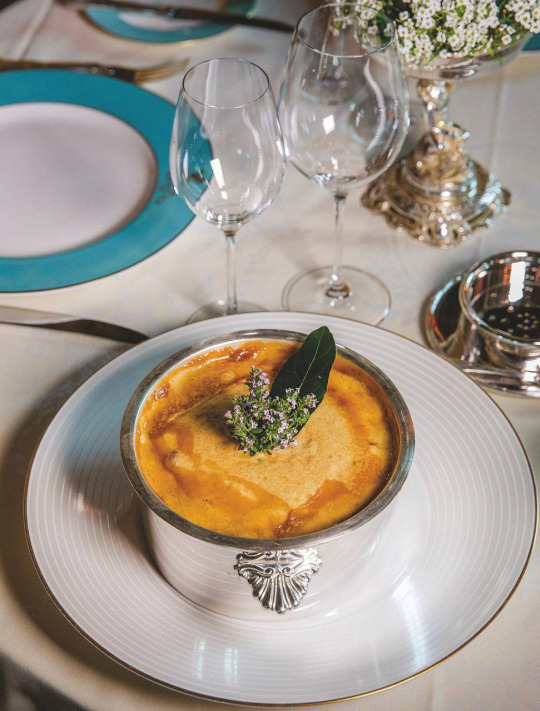
Devilled pheasant
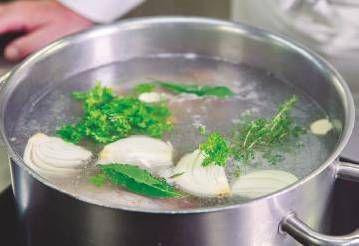

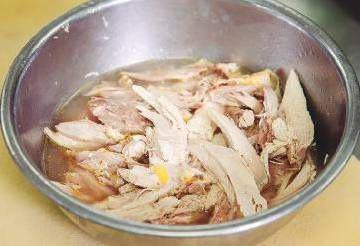

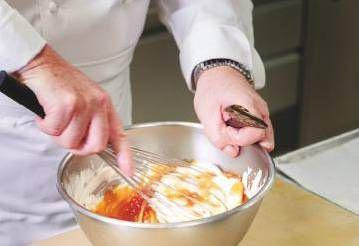
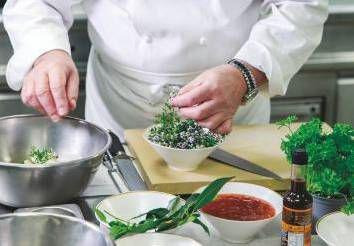
Method
Put the pheasants in a casserole with carrot, onion, garlic, parsley and herbs. Cover the birds with water and then cover the casserole. Bring to the boil and simmer gently until tender.
Remove the meat from the bones and pour back the juices in which the birds were cooked. Heat the meat very slowly in the juices, so it does not become dry. Meanwhile, whip the double cream into a stiff consistency. Leave it in the refrigerator for about an hour until it becomes quite hard, then beat the mango chutney and Worcestershire sauce into it. Keep it cool in the fridge until ready to be used. Place the flaked meat, thoroughly drained of cooking juices, into the dish in which it is to be served, cover it with the cream mixture and put it in the oven for 10 minutes to heat through.
Hint: the birds can be cooked in the morning and the rest of the preparation done about 1½ hours before dinner, but remember to keep the stock in which the birds were first cooked for reheating.
Ingredients
Mr Williams loves game ‘in every sense’. However, as we discuss the relative unpopularity of the pheasant, he does wonder why it doesn’t enjoy the adulation that other game birds enjoy. ‘Perhaps the modern, reared pheasant has lost a bit of its flavour,’ he muses. ‘I’d love to try a truly wild one. Still, I use them every now and again. If I roast one, I always bard the bird with bacon or lardo fat, cover it totally. I brown it first in the pan with lots of butter and cook it at 200˚C for 15 minutes, then rest it for another 15 minutes before carving.’
2 pheasants
1 large carrot
1 large onion
1 clove garlic
1 sprig parsley
1 sprig thyme
2 bay leaves
250ml (½ pint) double cream
1 large jar Green Label mango chutney
4tbspn Worcestershire sauce
He pauses, lost in gamey reverie. ‘Oh, and when you make the gravy, add a good lump ofbeurre noisette [‘hazelnut’ or browned butter] to the hot pan. It makes all the difference.’ He serves it with sauerkraut or cabbage studded with crisp bacon lardons.
Are there any other recipes he loves? ‘My favourite dish is when you stuff truffle andfoie gras under the pheasant’s skin.’ Now we’re talking. ‘Then flambé it with Cognac, Madeira and more truffle. Then add a truffle sauce, seal it in a dough cocotte and cook for 15 minutes, no more.’ It’s not exactly the most simple of kitchen supper dishes. Or the cheapest. But this is the sort of feast that would make most serious eaters (Shand included) weep tears of greedy glee.
My children will happily devour the breasts, battered thin and breaded like a schnitzel, although I do have to admit I pass it off as chicken. In this case, ignorance (and an empty plate) is bliss. Thighs and breast make a decent curry, too, and I’ve finely chopped the meat to use in a fiery Northern Thailarb , although it does need a handful of minced pork for extra fat. A classic Frenchsalmi is another reliable standby, albeit one that requires a little work.
My friend and fellow food writer Matthew Fort has adapted a classic Michel Guérard duck-ham recipe, using pheasant breasts instead. Simply bury in salt—spiced with coriander seeds, allspice, juniper berries, black pepper and star anise, crushed in the pestle and mortar—for 36 hours. Rinse off the salt and slice thinly. They’re a revelation. The rest of the carcass is used for stock.
If cooking seems too much of a chore, worry not. I was lately dazzled by a pheasant sausage roll from Wild & Game (www.wildandgame. co.uk), the pastry burnished, the filling rich and gently gamey. Their pheasant and venison sausages are pretty fine, too. It’s time to give these cheap, lean and sadly under-rated birds a second chance. Come shooting season, there’s an awful lot of pheasant about. The very least we can do is enjoy them.
44 notes
·
View notes
Text
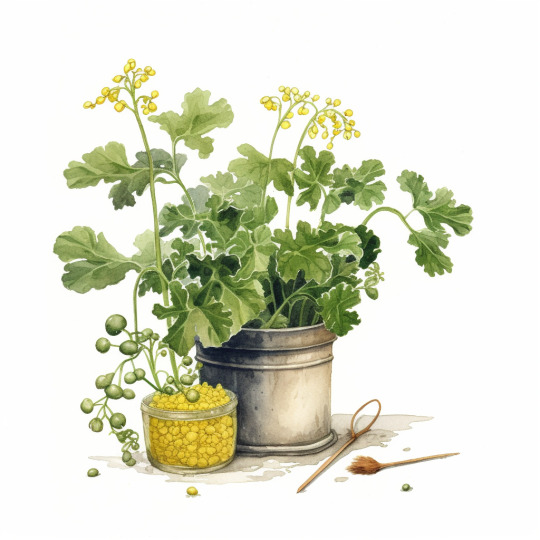
Common Mustard
Also known as : White Mustard, Black Mustard, Hedge Mustard, Treacle Mustard (English Wormseed), True Mustard, Mugwort Mustard, Khardai, Sinapi, Rai, Hei Jie
Scientific Names :
Black Mustard = Brassica Nigra (alt Sinapis Nigra)
White Mustard (Yellow Mustard)= Brassica Alba (alt Sinapis Alba)
Brown Mustard (indian Mustard) = Brassica Juncea (alt Sinapis Juncea)
Hedge Mustard (Sisymbruim Officinale)
Treacle Mustard (Erysimum Cheiranthoides)
Identification : In the Brassica family, Mustard is related to Broccoli and cabbage. There are three main varieties Brown and Black started in Asia, White is native to Europe. However, as Black Mustard is difficult to mechanically harvest so it has become less common although is the most pungent type. An annual which produces pretty yellow flowers (all varieties) the seed pods however do vary. Most think of the Mustard as yellow seeds, however, these are the "White" variety. Hedge Mustard is a UK variety related to Speedwell but is considered a weed (properties below relate to the verities above).
Properties : Diaphoretic, Diuretic, Emetic, Mild Laxative and Simulant
Uses : Cold/Flu and Fevers. Culinary. Treacle Mustard under the guise English Wormseed was used in folk medicine for killing worms in children.
Try It : Cold cure tea, add 1/4 tsp of powdered seeds in boiling water (honey to taste)
Warnings : Can cause contact dermatitis so not to be used neat on skin.
Parts used: Seeds, Note: mustard Powder tends to be White, Brown and Turmeric.
Magic : Healing
Planet : Sun
Element : Fire
Deities : Mars, Apollo
Folklore and History: Mustard is mentioned in the bible as a cure for heartburn. Pliny in Ancient Rome recognised its healing properties and taste. In England White mustard was mostly used as a food crop for animals.
Plant Tips : Harvesting occurs when the pods are not fully ripened as the seeds when fully ripened can shatter.
For Refences and bibliography please Click here
Click here to return to the index.
16 notes
·
View notes
Text
Prompt Spice for @allvalley100 drabble challenge.
'You think I can't do it?'
Robby smirked. 'I think you can do anything you put your mind to, dad.'
'It's just mustard, right?' Johnny looked at the yellow powder heaped onto a spoon. 'And English, so bland as hell?''
'Uhh….yeah…'
'I'm gonna do it.' Johnny brought the spoon closer.
'I'm waiting.' Robby folded his arms. 'Unless you're chicken?'
Johnny glared at him and put the spoon in his mouth. His face was impassive for a moment and then changed. His eyes watered and he ran for the bathroom, knocking his chair as he went.
Robby burst out laughing.
38 notes
·
View notes
Text

Chicken of the Woods Recipe
'Chicken', Leek, and Mushroom Pie
Chicken of the Woods (Laetiporus Sulphureus) is one of summer’s most exciting and unmistakable finds. With its distinctive bright yellow-orange colouring and characteristic globular shape, this is a great beginner mushroom for anyone just dipping their toes into mushroom hunting. It goes without saying though: never eat a mushroom that you haven’t confirmed the identity of using several sources.
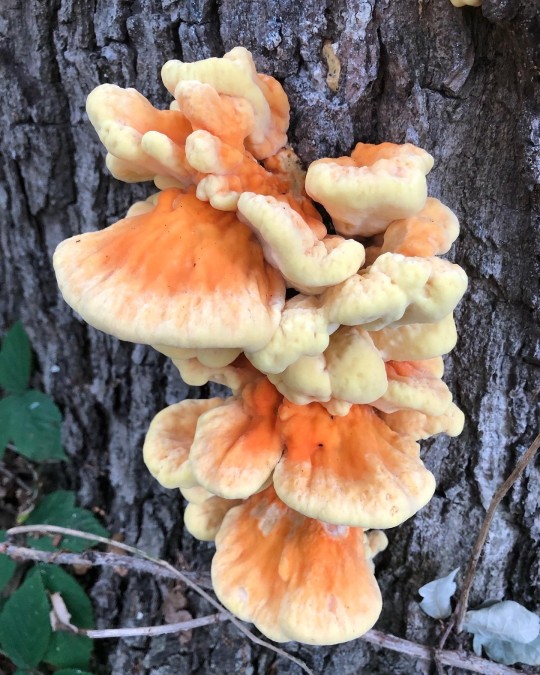
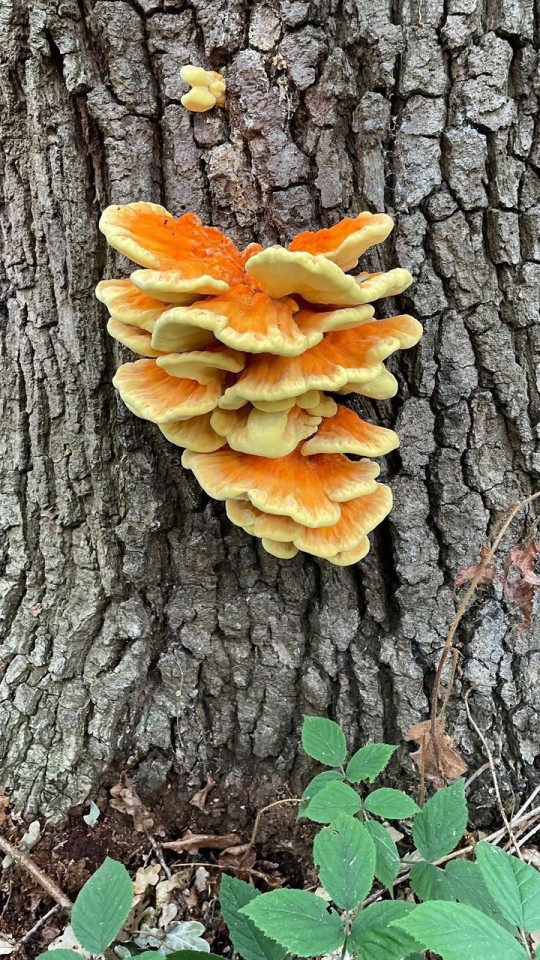
Chicken of the woods is a bracket fungus that grows on trees and dead wood. Every specimen I’ve found has been on a beautiful gnarled old oak tree, but they can also grow on cherry, sweet chestnut, willow, and yew. Take care when collecting and pay attention to where they’re growing. Fungus growing on yew can take in toxins from this poisonous tree, and I’ve heard that the occasional specimen on old fence posts can have the same issue with substances used to treat the wood. Be careful and only collect specimens from deciduous trees and stumps.

When picking chicken of the woods, the younger the better. Small fans with bright yellow colouring and rounded edges are in their prime. At this stage, the fungus is a choice culinary delight, with a soft texture similar to chicken- hence the name. As they age, COTW grow into large fans with wavy edges, becoming pale and dry. Once this mushroom is past its best, it has a texture more akin to polystyrene than juicy chicken!
You can find plenty of recipes online for making meals out of chicken of the woods, often capitalising on its namesake as a veggie replacement in dishes traditionally made with white meat. Lots of recipes include breading and frying, which cotw lends itself well to.

The recipe below is another foraged play on a British pub classic- chicken, leek and mushroom pie. Though it seems a little excessive (this is actually a mushroom, leek, and more mushroom pie!) the addition of other mushrooms is important to the flavour. As well as having a texture similar to chicken, cotw tastes similar to chicken too- which is to say that it tastes of very little at all. You can use any other kind of mushroom you like, but the best would be those with a strong, mushroomy flavour. I’ve used dryad’s saddles, but some good foraged alternatives would be parasols, field mushrooms, or any kind of edible bolete. If you rehydrate dried mushrooms to use in this recipe, you can replace some or all of the stock with the mushroom-soaking liquid for extra umami!
Chicken of the Woods, Leek, and Mushroom Pie Recipe.
Ingredients
For the Pastry:
80 grams salted butter
80 grams lard (substitute with more butter to make this recipe vegetarian)
500g plain flour
1 egg, plus one for glazing
For the Filling:
500g fresh chicken of the woods mushroom
2 large leeks
200g other mushrooms (rehydrated weight if using dried)
3 cloves garlic
5tbsp plain flour
200ml chicken or vegetable stock
200ml full-fat milk or single cream
1 handful chopped fresh parsley, or 2 tbsp dried
1 handful chopped fresh tarragon, or 2 tbsp dried (optional)
1 tsp craked black pepper
2tsp mustard powder, or 1tsp English mustard
1/2 tsp paprika (optional)
White wine, white wine vinegar or apple cider vinegar for deglazing
Butter for frying
Method:
Make the pastry using a hot water crust method. Measure out your flour in a large heatproof bowl. Crack the egg into the centre and use a butterknife to stir it into the floure. Heat your fat(s) gently in a saucepan with 200ml cold water until melted. Allow the liquid to cool for a minute or so, then tip into the middle of your flour/egg mixture. Stir quickly with your butterknife to combine. Tip the dough out onto a surface and knead very briefly until smooth. Wrap tightly and place in the fridge to cool for at least an half an hour.
Heat a large knob of butter in a saucepan over a medium-high heat. Clean your chicken of the woods mushrooms and slice away any bruised or soft areas. Cut the rest into small bite-sized chunks. Slice your other mushrooms thickly (if using rehydrated, drain off as much liquid as possible). Throw everything in the pan and fry, stirring frequently, until thoroughly browned.
Thickly slice the leeks and mince the garlic. Once the mushrooms are browned, turn the heat down to medium-low and add the leeks with the garlic. Fry for a few minutes until starting to colour. Deglaze the pan with a splash of wine or vinegar, then add the mustard, pepper, and paprika (if using) to the pan and stir.
Turn the heat to low. Add the flour and stir through evenly, so all the filling is coated. Very slowly pour in your stock, stirring constantly, allowing the flour to absorb all the liquid you've poured in before adding more. Once all the stock has been added, pour in the milk/cream and stir again. Stir in the herbs and allow the mixture to simmer gently for ten minutes, stirring occasionally, until thickened.
Preheat your oven to 190 degrees (fan 170, gas mark 5). Lightly grease your tin. A large, flat tart tin works, but I've used a deep 9-inch cake tin to give the pie a little height. If making a deeper pie, split the pastry into two pieces of roughly two thirds (for the bottom) and one third (for the top). If making a flatter pie, split it roughly in half.
Roll out your bottom piece of pastry into a rough circle big enough to cover the bottom and sides of your dish. You shouldn't need to flour your surface, but you can do so if your pastry sticks. Place the rolled out pastry into the tin and gently press into the sides. Pour the filling into the pie crust.
Beat an egg in a small bowl with a splash of milk. Brush a little of this eggwash around the lip of the pie crust. Roll out the top piece, and place it on top. Use your thumb and forefinger to crimp the edge, then slice off the excess pastry with a sharp knife. Use the offcuts to decorate the top if you're feeling creative, and slice some lines to allow steam to escape. Then brush the top off the pie with more eggwash.
Bake for about an hour, or until golden brown on top. Let the pie cool for ten minutes or so after removing from the oven so it holds its shape better when sliced. Eat as it is, or try it with roast veg and a homemade mushroom gravy!
#foraging#mushrooms#chicken of the woods#chicken of the woods recipe#wild food#wild food recipe#foraging recipe#bracket fungi#recipe#laetiporus sulphureus#pie#vegetarian
13 notes
·
View notes
Text
Barbecue sauce (also abbreviated as BBQ sauce) is a sauce used as a marinade, basting, condiment, or topping for meat cooked in the barbecue cooking style, including pork or beef ribs and chicken. It is a ubiquitous condiment in the Southern United States and is used on many other foods as well.[1]
Ingredients vary, but most include vinegar or tomato paste (or a combination) as a base, as well as liquid smoke, onion powder, spices such as mustard and black pepper, and sweeteners such as sugar or molasses
Some place the origin of barbecue sauce at the formation of the first American colonies in the 17th century.[2] References to the sauce start occurring in both English and French literature over the next two hundred years. South Carolina mustard sauce, a type of barbecue sauce, can be traced to German settlers in the 18th century.[3]
Early homemade barbecue sauces were made with vinegar, salt, and pepper. Sugar, ketchup, and Worcestershire sauce started to be used in the 1920s, but after World War II, the quantity of sugar and the number of ingredients increased dramatically.[4]
The Georgia Barbecue Sauce Company of Atlanta advertised an early commercially produced barbecue sauce in 1909.[5] Heinz was the first major company to sell bottled barbecue sauce in 1940. Soon afterward, General Foods introduced "Open Pit." Kraft Foods only entered the market in around 1960, but with heavy advertising, succeeded in becoming the market leader.[4] Kraft also started making cooking oils with bags of spice attached, supplying another market entrance of barbecue sauce.[6]
Different geographical regions have allegiances to their particular styles and variations of barbecue sauce.
East Carolina – Most American barbecue sauces can trace their roots to a sauce common in the eastern regions of North Carolina and South Carolina.[3] The simplest and the earliest, it was popularized by enslaved Africans who also advanced the development of American barbecue, and originally was made with vinegar, ground black pepper, and hot chili pepper flakes. It is used as a "mopping" sauce to baste the meat while it is cooking and as a dipping sauce when it is served. "Thin, spicy, and vinegar based," it penetrates the meat and cuts the fats in the mouth, with a noticeably tarter flavor than most other barbecue sauces.[7]
Western Carolina – In Lexington and the Piedmont areas of western North Carolina, the sauce is often called a dip. It is similar to the East Carolina Sauce with the addition of tomato paste, tomato sauce, or ketchup.[8]
South Carolina mustard sauce – Part of South Carolina is known for its yellow barbecue sauces made primarily of yellow mustard, vinegar, sugar and spices. This sauce is most common in a belt from Columbia to Charleston.
Memphis – Similar to the Western Carolina style, but using molasses as a sweetener and with additional spices. It is usually served as a dipping sauce, as Memphis-style barbecue is typically a dry rub.[9]
Kansas City – Thick, reddish-brown, tomato-based, and made with sugar, vinegar, and spices. It evolved from the Western Carolina and Memphis style sauces but is thicker and sweeter and does not penetrate the meat as much as it sits on the surface. Typical commercial barbecue sauce is based on the Kansas City style.[9]
Texas – In some of the older, more traditional restaurants, the sauces are heavily seasoned with cumin, chili peppers or chili powder, black pepper, and fresh onion, while using less tomato and sugar. They are medium thick and often resemble a thin tomato soup.[10] They penetrate the meat easily rather than sit on top. Bottled barbecue sauces from Texas are often different from those used in the same restaurants because they do not contain meat drippings.[11]
Alabama white sauce – North Alabama is known for its distinctive white sauce, a mayonnaise-based sauce that also includes apple cider vinegar, sugar, salt, and black pepper, which is used predominantly on chicken and pork.[12]
2 notes
·
View notes
Text

[ID: A close-up on the bottom right of a bowl filled with a red, brown, and yellow spice blend. The rest of the frame is taken up by scattered brown chili flakes, ajwain, and fenugreek seeds. End ID.]
Berbere / በርበረ (Ethiopian spice blend)
Berbere is a spice blend commonly used to flavor meat and vegetable dishes in the horn of Africa; mostly made up of Ethiopian brown chili peppers, it also commonly includes garlic and shallot, false cardamom, carom and nigella seeds, high-roasted fenugreek, cinnamon, and other spices and herbs. This recipe for an Ethiopian-style berbere produces a blend that imparts a smooth, even heat and a slight camphorous aroma to your final dish.
Premade berbere blends, even those from speciality spice stores, cut corners and cut costs—even if the spices are fresh and have always been stored sealed, the blend is unlikely to contain Ethiopian brown chilis, korerima, or besobela. This recipe provides a good baseline for a typical Ethiopian berbere if you're able to get your hands on these spices, rather than relying on undisclosed substitutions—but it does provide substitutions for anything you're unlikely to find in a local halaal grocery store in the U.S. or Europe. To avoid confusion with overlapping English translations (and because many recipes contain errors caused by them), Amharic terms, botanical (Latin) names, and false cognates to beware of are provided whenever necessary.
Recipe under the cut!
Patreon | Tip jar
Ingredients:
1/4 cup dried ground Ethiopian brown chili (berbere), or substitute New Mexico chilis
1 Tbsp sweet paprika (optional)
2 tsp garlic powder (nech shinkurt / ነጭ ሽንኩርት)
2 tsp dehydrated shallot or red onion (key shinkurt / ቀይ ሽንኩርት)
2 tsp false cardamom (korerima / ኮረሪማ; Aframomum melegueta)
1 tsp coriander seeds (dimbilal / ድንብላል)
1 tsp black mustard seeds (senafitch / ሰናፍጭ; Brassica nigra) (optional)
1/2 tsp fenugreek (abish or hulbet / አብሽ; Trigonella foenum-graecum), dark-roasted
1/2 tsp nutmeg (gewz; Myristica fragrans)
1/4 tsp ground ginger (zinjibel / ዝንጅብል; Zingiber officinale)
1/4 tsp carom seeds (nech azmud / ነጭ አዝሙድ; Trachyspermum ammi)
1/4 tsp nigella seeds (tikur azmud / ጥቁር አዝሙድ; Nigella sativa)
1/8 tsp true (Ceylon) cinnamon (k'elefa / ቀረፋ; Cinnamomum verum), or substitute cassia cinnamon
4 pieces Ethiopian long pepper (timiz; Piper capense); or Indian long pepper (Piper longum), also sometimes used under the name "timiz"
5 whole cloves (krenfud / ቅርንፉድ)
1 tsp Ethiopian holy basil (besobela / በሶቢላ)
1 tsp rue seeds (tena Adam / ጤናዳም; Ruta chalepenesis)
1 tsp Ethiopian rape seeds / Ethiopian mustard seeds (Brassica carinata), or substitute niger seeds (Guizotia abyssinica)
1 tsp koseret (ኮሰረት; Lippia abyssinica) (optional)
2 tsp salt
Berbere preparations vary from household to household, and spices may be added, removed, or rebalanced according to your preference. Less common inclusions are marked as optional; the spices and herbs that are the most vital are bolded.
See end notes for information on spices and substitions.
Instructions:
1. Heat a dry skillet over medium. Roast fenugreek, agitating occasionally, until it has considerably darkened to a medium brown. Set aside. Toast cinnamon, cloves, and korerima for a few minutes until fragrant and set aside.
2. Toast smaller whole spices (carom and nigella seeds) for a few minutes until fragrant and set aside.
3. Remove the pan from heat. Toast ground spices (ginger, paprika) for 30 seconds, stirring constantly, until fragrant.
4. Use a mortar and pestle or a spice grinder to grind all ingredients to a fine consistency. Pass through a fine mesh strainer and store in an airtight container in a cool, dark place.
Notes on spices and herbs
Ethiopian brown chili pepper / berbere

Known as "berbere" in Ethiopia, Ethiopian brown chilis have a rich, smoky, and tangy heat. Dried Ethiopian brown chilis or chili flakes may be purchased online, or you may substitute another type of chili (my choice would be New Mexico).
Paprika
Different varieties of paprika are all made of dried, toasted, and ground red bell peppers, but they vary in heat and in smokiness. For berbere you will need sweet paprika (not smoked paprika, hot paprika, or smoked hot paprika). The proportion of berbere to paprika can be varied a bit according to your preference to produce a milder or hotter blend, but beware of recipes calling for large amounts of paprika—berbere should be mostly chilis!
Dehydrated shallot
Shallots have a flavor similar to those of garlic and onion, but subtler and milder. Dehydrated shallot may be purchased at speciality spice stores, or online—or you can dehydrate thinly sliced shallots in a dehydrator or in an oven on low. Red onion powder is a possible substitute, as red onions are commonly used in place of shallots by people of Ethiopian descent in the United States.
Korerima / false cardamom

Korerima is also known as "grains of paradise," "black cardamom," or "false cardamom." Some recipes mistakenly call for Nepal cardamom in place of korerima, because Nepal cardamom is also known as "black cardamom" in English. The aroma of korerima once ground, though, is much more akin to that of green cardamom than to the smoky, camphorous aroma of Nepal cardamom.
Fenugreek / abish

Fenugreek seeds may be found in any halaal grocery store, where they may be called fenugreek or methi.
Carom seeds / nech azmud

Carom seeds may be found in any halaal grocery store, where they will be known as ajwain. You may also see these referred to as "white cumin" or "caraway seeds" in English, but don't confuse them with true caraway seeds (Carum carvi), which are larger.
Nigella seeds / tikur azmud

Because "tikur azmud" literally translates to "black cumin" in English, some recipes make the mistake of calling for kala jeera (Indian black cumin)—however, the seeds are from different plants entirely. "Tikur azmud" refers to the seeds of the Nigella sativa plant, which are known as nigella seeds in English cooking and kalonji in Indian cooking.
Ceylon cinnamon

Ceylon or true cinnamon is a variety of cinnamon commonly grown in Ceylon, Sri Lanka; it has a subtler, more nuanced and less bitter flavor than cassia cinnamon. Because it must be rolled by hand (unlike cassia cinnamon, which curls naturally), it tends to be more expensive than cassia. If you can't locate any Ceylon cinnamon, though, cassia is a good substitution.
Holy basil / besobela

Ethiopian holy basil is a subspecies of basil whose flowers have a distinctive fruity or tea-like aroma. Some recipes call for basil in place of besobela, but to my nose the aromas are nothing alike; I would favor camomile as a substitution, or omit the herb altogether.
Rue seeds / tena adam

"Tena Adam" (lit., "health of Adam) or "rue" is an aromatic plant the dried fruits of which are used in spice blends including berbere (the leaves are often used to flavor coffee). Ethiopian rue may be purchased online, or you may substitute for it a pinch of lemon or orange zest.
Long pepper / timiz
The berries of Piper capense, also known as African long pepper or Ethiopian long pepper. Piper capense grows across west Africa, south Africa, and the horn of Africa. Timiz is smoky, camphorous, and resinous, not as spicy or sharp as black or white pepper. Piper longum (Indian long pepper) berries, which are sharper in taste, are best known for their cultivation in Southeast Asia, but they are also grown and eaten in East Africa and may also be referred to as "timiz." In the U.S. and Europe, Ethiopian long pepper may be found online, or at a speciality African foods store, where it will be labelled "timiz"; Indian long pepper may be found at an Indian or halaal grocery store, where it will be labelled "pippali."
Salt
Traditional berbere blends typically contain salt. I tend to omit it, as it allows for more control over the salt content of a dish later on.
88 notes
·
View notes
Text
Technical challenge - make vegan broccoli stilton soup when one has never eaten broccoli stilton soup.
Made for my darling who misses this from pregan days - HMU if you want a vegan version of your faves.
I knew it would need umami and that dry-your-mouth-out sharp depth that mature cheese had so a quick conflab with my fellow cookery mavens on "what does stilton taste of really?" and here we are
1 broccoli, chopped (I use frozen)
1/2 an onion (again, frozen)
Veggie stock to cover
ONE ENTIRE TUB OF NUTRITIONAL YEAST
Heaped tsp white miso
Heaped tablespoon of dried seaweed
3 pudding spoons of the pickle liquid from a jar of gherkins - sauerkraut would also work, you want a white vinegar pickle here not a sugar pickle
Garlic to taste (I use powdered because I am a lazy heretic)
Smidge of English mustard
3 chopped spring onions (white and green bits)
I added a slug of chopped chives and parsley as I had fresh in but think that it will fly without
Generous salt and pepper seasoning
* Gently simmer until broccoli is cooked and remove from heat - the less you cook it the greener it will stay
* Blend until super smooth
* Serve with swirl of cream (I had oatly, but elmlea plant also works) plus grated mature vegan cheese
* I cooked mine the day before and heated up before serving

0 notes
Text
Menu Fifteen
Menu Fifteen from Bishop and Carruthers' "The Vegetarian Adventure Cookbook"
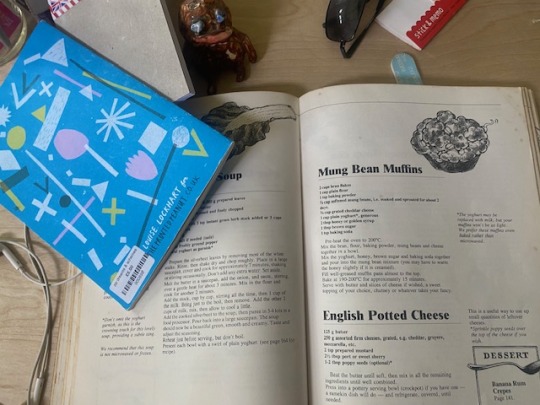
Silverbeet Soup Supreme: silverbeet, butter, onion, plain flour, water, vegetable stock, milk, salt, pepper, natural yoghurt.
Mung Bean Muffins: bran flakes, plain flour, baking powder, mung beans, cheddar cheese, plain yoghurt, honey, brown sugar, baking soda.
English Potted Cheese: butter, cheddar cheese, gruyere, mozzarella, prepared mustard, port, poppy seeds.
I was obsessed with grey skies and rain in early December. The first week of December, the fifteenth week, and the fifteenth menu. Fifteen weeks into this and I think that every week could be boiling down to the same thing. I think about time, I think about significance, and I think about experience. In terms of time, and the menus and the weeks going by, they seem to be bleeding into one another. As the time goes on, it gets harder to differentiate one week from another, every week bleeds into the next. In fact I’m writing about Menu Fifteen posthumously really, because for me it’s already Week Sixteen and the day of the sixteenth dinner party. This is a fact that ChatGPT says I should address in case the “temporal displacement” is clouding my judgement. It could be. The other thing about time, significance and experience and writing about it, is that as time goes on there is a whole lot more of it to think about. At the end of September, there was only three weeks worth of time, experience and significance to write about. Now it’s December and the sheer volume of time that this year has accredited makes it difficult to hone in on one thing.




Mung Bean Muffins...
With regard to Week Fifteen I thought about how I was allocating time, not in terms of leisure and work, but rather how much time I had been putting into Bishop and Carruthers’ menus. I haven’t spent as much time on anything in the last fifteen weeks like I have “The Vegetarian Adventure Cookbook”. I had time to think about that fact because Menu Fifteen was simple, there were very little ingredients and only two vegetables. I did get to go to the bulk store to purchase bran flakes (cashier in question not there). On Tuesday night it poured with rain and I ate dinner out with two friends. I was reminded amongst the comfort of the cold weather of all the reasons I loved where I lived. The long stretch of road that connects everything important to me at this time. I was thinking very little about the menu that lay ahead. There was a warm soup this week, perhaps there was cosmic reasoning to the cold December weather.
There was something uninspiring about Menu Fifteen, though there was heart in the first warm soup. Silverbeet Soup Supreme, Mung Bean Muffins and English Potted Cheese. Any time that I was going to spend cooking the menu felt like time wasted. It was one of those weeks where I now had too much time after finishing work at 4 30PM, I had only three dishes and three guests. The same three guests as the very first week, possibly it was the first time the four of us would eat together since that first week. Despite any ill feelings, I started the Mung Bean Muffins when I returned home on Wednesday. At no point did they seem delectable. I moved on to the English Potted Cheese, beating 125 grams of butter until smooth with an electric beater, then beating three kinds of grated cheese into it. Into that I beat mustard, port and poppy seeds. While I squashed this mixture into a small bowl to be covered and refrigerated I sat at the dining room table, listening to Morrissey from my MacBook Air. It was only about 6 PM, there were two and a half hours till the time that I had said dinner would be ready.
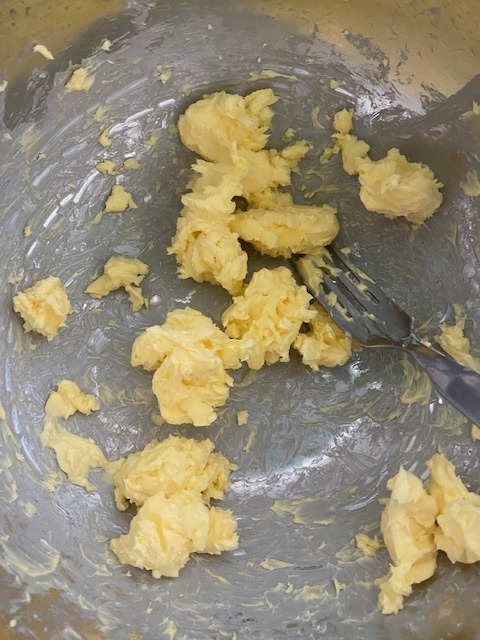
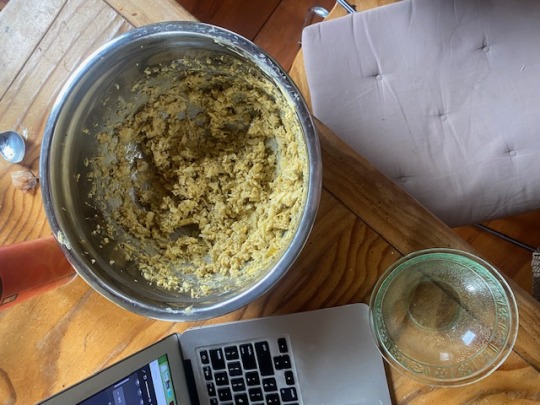



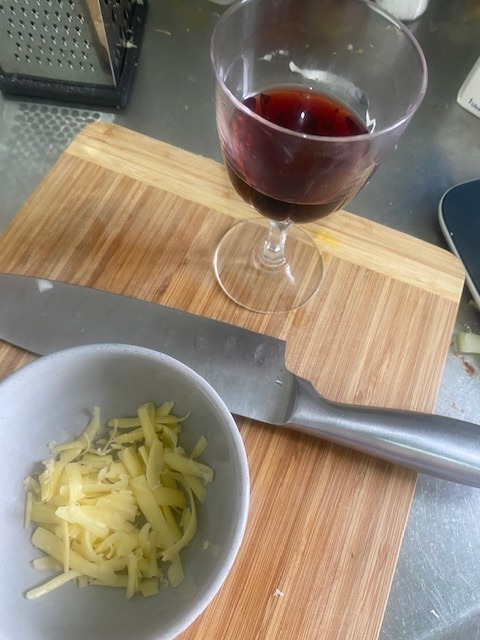
Potted cheese and beverages of a fifteenth week.
For the first time in all fifteen weeks, dinner was ready before my singular non-flatmate guest arrived. The Silverbeet Soup Supreme, had been cooked, cooled, blended, and reheated, and yet my guest hadn’t arrived. When she did, I poured the soup into four bowls, it looked like a warm milkshake. Perhaps I had over-whirred it in the blender causing it to be over-aerated. When I dropped the spoonful of natural yoghurt on top of the soup to garnish it sank immediately to the bottom of the bowl but I served anyway. It was the saddest table spread of all fifteen menus I had seen so far. I looked up at the table guests and thought about us in that last week of August, how cheery we had been that evening as we ate an inedible meal on one of the last Winter nights of the year. Now it was Summer and I sat in the same seat at the same table only thinking about how much time I’ve wasted since then. The Silverbeet Soup Supreme actually received some compliments, even though the natural yoghurt seemed to have curdled within the soup to form a mozzarella-like taste and consistency.


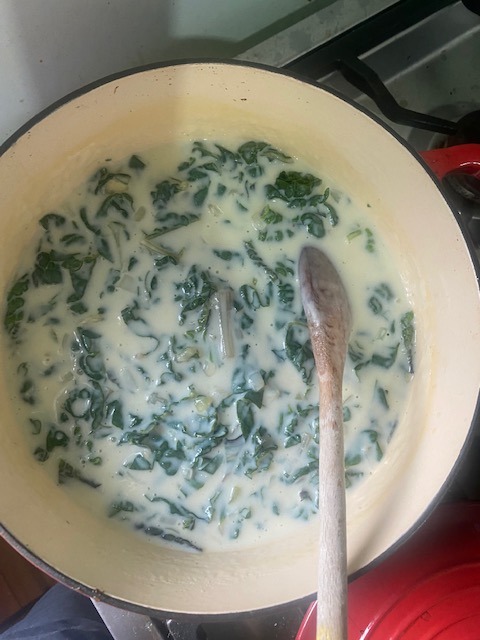

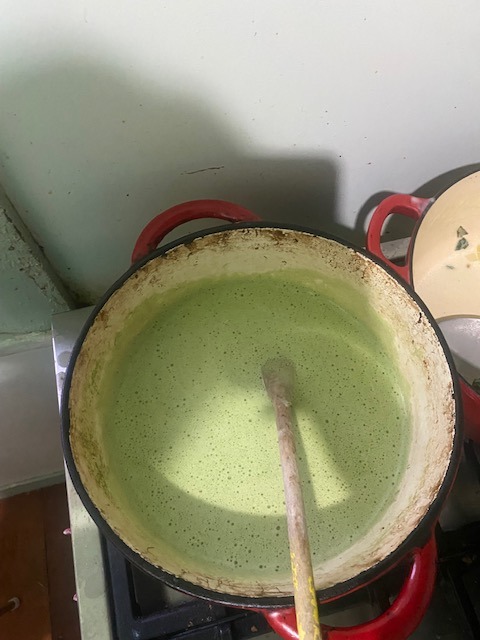
Cooked, blended, cooled and reheated silverbeet milkshake.
Menu Fifteen felt like a colossal waste of time. My flatmate cleaned all the dishes and I sulked in my room. I’d learnt nothing, I’d felt nothing. Menu Fifteen was now just another accumulation of time and experience that I now needed to wade through to find significance. I went out on Thursday night to an Engineering Christmas party. Someone told me days later that you should give someone three days to reach out. Sunday came and went with no call, though I hadn’t actually given my number to anyone anyway.
#vegetarian#home cooking#food#foodblogger#foodblogwebsite#foodpics#self discovery#recipes#food recipes#cooking#meaning#on writing#writers and poets#creative writing#lifestyle#daily life#luxury#expensive#trend#lifestyle blog
0 notes